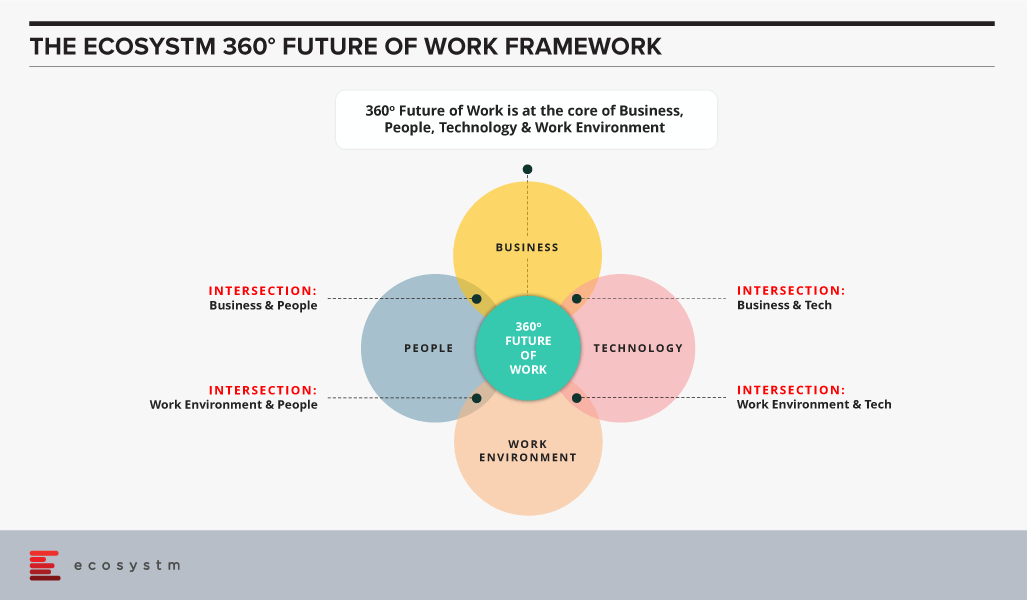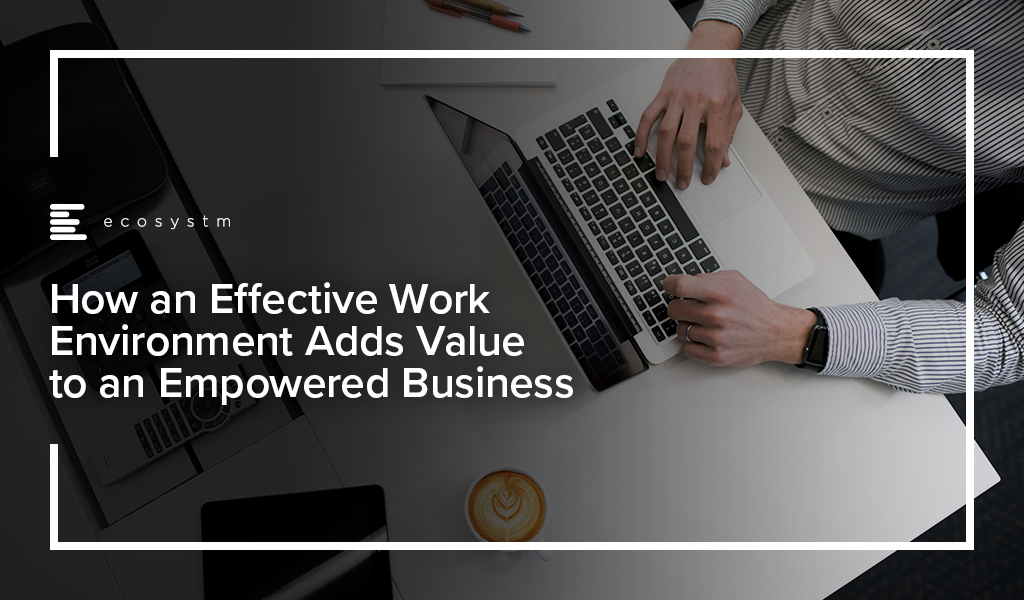The 360o Future of Work practice takes into account the changing business environment, and what companies need to become an “Empowered Business”. It consists of four components: The Business, The People, The Technology, and The Work Environment.

Here we focus on the Work Environment, and its intersection with the three other components.
Work Environment: A Component of the 360o Future of Work
Companies and people have learned work can be performed in many types of environments, just as business is conducted in varying venues. Each space will have a different impact and outcome. The three primary commercial areas are: office, industrial and retail. While industrial and retail commercial areas will be addressed later, we talk here primarily of the office environment. The office environment is designed to enable both collaborative and individual work. It has historically been densely packed. Post COVID-19, this environment will probably be modified. For the past few years, an alternative to the office environment has been co-working – a shared work environment with other companies, in open plan arrangements. It provides a way for business to save capital by minimising the expense of fit out. The combination of using both office and co-working environment is what will begin to be called “the Blended Environment”.
The Work Environment and its Intersections
While the Work Environment is an important component of the Future of Work, it is a co-enabler with Technology to support the People and Business.

Work Environment – Intersection with the Business
The Business’s role is to provide Strategy and Direction. If done effectively it can take on unknown challenges. Examples of how the Business intersects with the Work Environment would be:
- Providing agility to the Business in preparing for any future crises. Some examples of how this can be done is by looking at how the space is controlled by the lease conditions, and how it is used by the occupants and the type.
- Aiding to minimise risk from excess space. An example would be space options for a lease. This will enable both spatial and financial flexibility for the company to expand or contract as needed.
Work Environment – Intersection with People
A critical component of the Empowered Business is its People – its workforce. For any company, the People are the key asset. They have to be able to grow and develop, in order to provide collaboration and idea creation. Examples of how the Work Environment can empower the People would be:
- The focus is on aligning the space with the employee’s task.
- The focus is on aligning where a person needs space to be effective, and the task the person needs to perform.
Work Environment – Intersection with Digital (Technology)
One of the important enablers of any Business, especially the Empowered Business, is its Digital Tools. They support the Business and its People, along with the Work Environment. They allow the Work Environment to be productive and effective. Examples of how Technology and the Work Environment intersect would be:
- This is where the two enablers (Digital Tools and Work Environment) work together to aid the employees and the business.
- This relates to how to manage the Business’s portfolio of space from a remote location.
These four components working together will enable an Empowered Business. The Work Environment as an enabler allows the Business to pivot, adapt, and thrive in the most challenging environment. It allows the Empowered Business to be better prepared to meet future crises head-on.
Schedule a time to speak with us on Future of Work
Ecosystm Principal Advisors; Tim Sheedy & Audrey William (Technology), Ravi Bhogaraju (People & Organisations), and Mike Zamora (Work Environment) provide a holistic view of what the Future of Work will look like.
We enable businesses to adapt, pivot and thrive in their ecosystem; provide holistic access to data and insight across People, Technology and Work Environment; help businesses transform and be better prepared for future disruption, and the ever-changing competitive environment and customer, employee or partner demands.
Contact us through the platform, or over email at info@ecosystm360.com

The adoption of new digital and data-centric technologies is transforming the workplace and making it more productive. The concept of the workplace has evolved over time, and it is no longer tied to the tradition of working from a fixed physical location. Rather, the workplace has expanded its horizon and has evolved into a wider virtual environment empowered by technologies such as smartphones, wireless connectivity, virtual and augmented reality, collaboration tools and a range of productivity technologies.
Innovation has continued to revolutionise the workplace. It has been 40 years since digital technology transformed the back offices of large organisations; 30 years since the PC revolution revolutionised the front office with productivity tools such as word processors and spreadsheets for all information workers; just 20 years since the Internet became a common business tool and; the smartphone, particularly the iPhone made its way into the workplace.
Each of these waves of technology contributed towards workplace transformation and has made way for the new wave of transformation – through emerging technologies such as Artificial Intelligence (AI) and newer business models (as-a-service and cloud-based delivery of personal productivity tools).
Organisations are being driven towards a “Mobile First” strategy to empower their “Smart employees” – no longer thinking of migrating their web apps to mobile apps, as and when required. They are looking to implement and develop mobile apps first. In the global Ecosystm Mobility study, only about 2% of organisations indicate the absence of a Mobile-First strategy and this is a good indication of the transformation that lies ahead.

To be able to implement a Mobile-First vision, become a Smart Workplace and for a seamlessly integrated environment, organisations will need to invest in multiple technologies simultaneously. These include:
- Collaboration tools: Software and tools that help individuals in the workplace to collaborate and work together on a project in a smart and efficient way with shared data and resources – irrespective of their locations. Although the concept of collaboration is not new, technologies such as AI and Cloud allow for greater collaboration. This has driven leading players in the market to also offer Cloud solutions. Microsoft is a good example, where Cloud brought added features and services to their MS Office suite to match the requirements of an evolving workplace.
- Social media: A technology that was popularized in the consumer space evolved into a major collaboration and productivity technology for enterprises. This opens up the possibility of incorporating sophisticated analysis tools, many of them driven by AI technology, leveraging social networks. Using social media in the workplace has also improved employee experience, as it enables the employees to interact in similarly efficient ways in the workplace, as they do in their personal lives.
- Workflow and content management: Digitalisation is opening newer avenues, simplifying the way work gets done and exploring ways to improve existing processes and workflows. Workflow and content management systems have improved the way employees produce and manage business information thus making processes more efficient, cost-effective, and secure.
- Mobility: The advent of smartphones, wireless networking, and mobile applications have enabled employees to work from any place and any time. This has expanded the workplace boundaries and employees can stay connected with the work while on the move.
- Unified Communications: There are multiple channels of communication – voice, data, image, video – open to employees today, depending on the level of communication required to perform their jobs. Organisations are increasingly implementing one integrated corporate communication system.
Workplace innovation is already pervasive in customer focussed industries. However, workplace innovation is also combining with other emerging technologies such as AI and IoT to transform workplaces in supply-chain intensive industries as diverse as Manufacturing, Transport & Logistics, Energy & Utilities, and Mining & Resources. As this trend continues, we will start to see even more innovations to our places of work.



